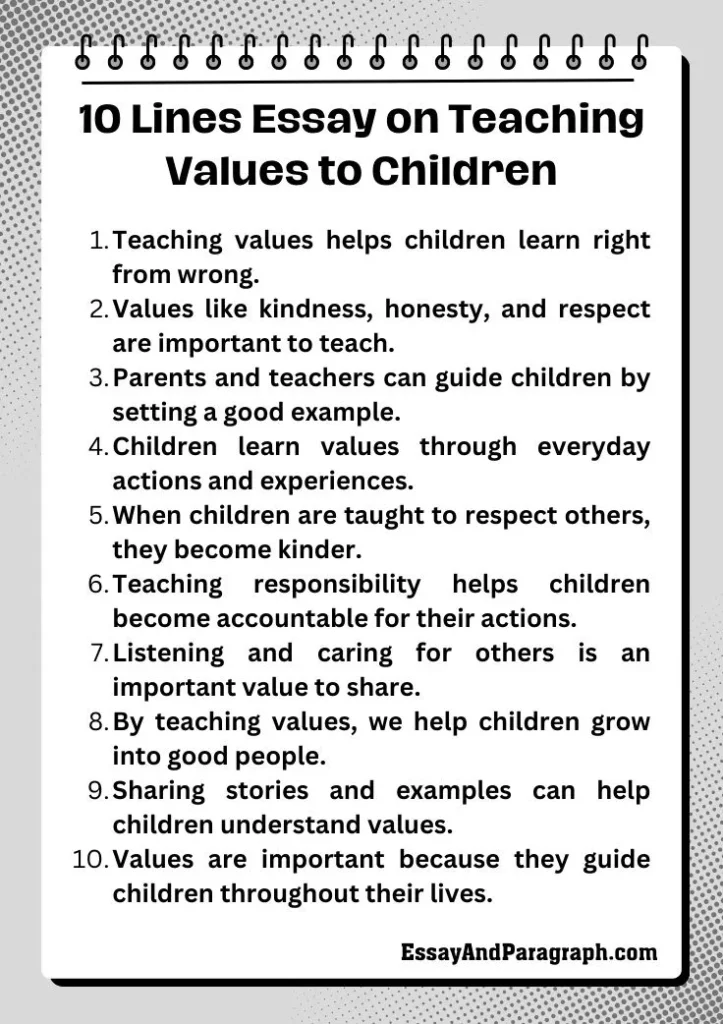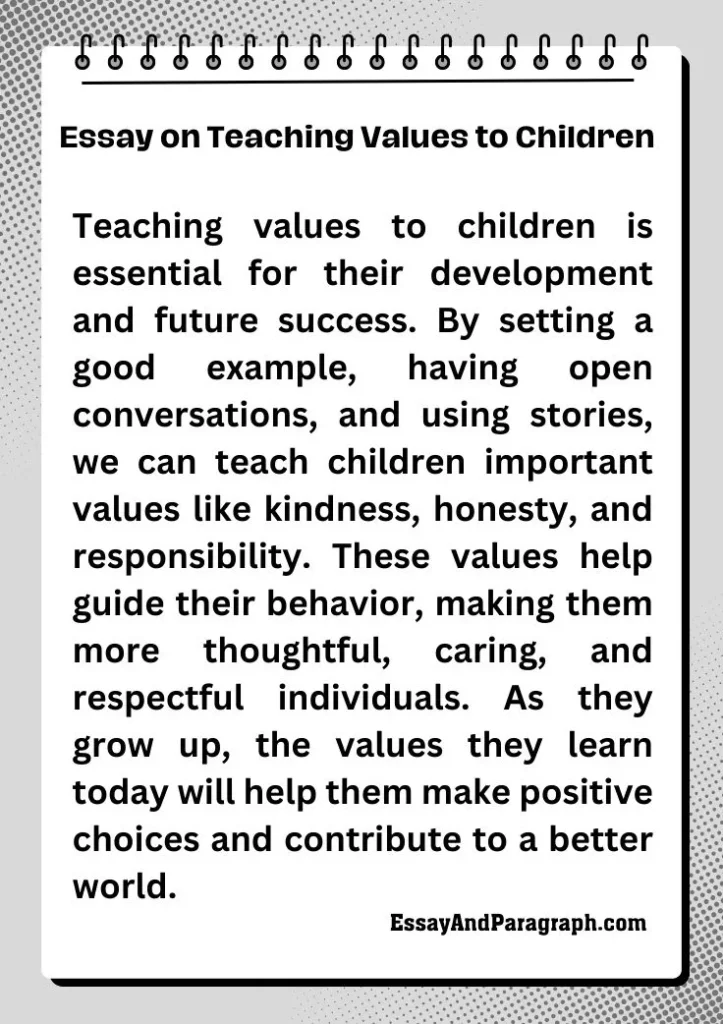Have you ever wondered how children learn what is right and wrong? Teaching values to children is an essential part of helping them grow into responsible and kind individuals. It involves guiding them to understand the importance of honesty, respect, kindness, and responsibility. In this article, we will explore how to teach values to children and why it is so important for their development.
10 Lines Essay on Teaching Values to Children
- Teaching values helps children learn right from wrong.
- Values like kindness, honesty, and respect are important to teach.
- Parents and teachers can guide children by setting a good example.
- Children learn values through everyday actions and experiences.
- When children are taught to respect others, they become kinder.
- Teaching responsibility helps children become accountable for their actions.
- Listening and caring for others is an important value to share.
- By teaching values, we help children grow into good people.
- Sharing stories and examples can help children understand values.
- Values are important because they guide children throughout their lives.

Short Essay on Teaching Values to Children
Teaching values to children is one of the most important things parents and teachers can do. Values like kindness, honesty, respect, and responsibility help children understand how to behave in the world. When children are taught these values, they grow up to be caring and thoughtful adults.
One way to teach values is by setting a good example. Children learn by watching adults. If they see someone being kind or honest, they are more likely to do the same. It is also important to talk to children about these values and explain why they matter. For example, when a child shares their toy, you can tell them that sharing is kind and helps others feel happy.
Another way to teach values is through stories. Stories can show children the importance of being kind, helpful, or honest. By sharing these stories, children can see how values are used in real-life situations.
Teaching values to children helps them grow into people who make positive choices and care about others. When children understand and practice values, they create a kinder and more respectful world.
Long Essay on Teaching Values to Children
Teaching values to children is an essential part of their upbringing. Values are the principles that guide how we live, and they help children understand what is right and wrong. It is through the teaching of values that children learn to be honest, kind, respectful, and responsible. These values shape their behavior and help them make good decisions throughout their lives.
One of the best ways to teach values is by being a good role model. Children learn by watching adults, especially their parents and teachers. If a child sees their parent being kind to others, they will likely imitate that behavior. Similarly, when a teacher demonstrates respect for all students, the children in the class will learn to respect one another. Setting a good example is one of the most powerful tools for teaching values.
In addition to modeling good behavior, it is important to have open conversations with children about values. When children are taught the meaning of values like honesty and responsibility, they are more likely to understand why they should practice these values in their own lives. For example, a parent can explain that being honest is important because it builds trust with others. A child who understands this concept is more likely to tell the truth, even when it might be difficult.
Another effective way to teach values is through storytelling. Stories, whether from books or personal experiences, can show children the importance of values in real-life situations. For instance, a story about a character who shows kindness or solves a problem with honesty can teach children how these values are used in the world. By listening to these stories, children not only learn about values but also see how these principles can be applied in their own lives.
Moreover, teaching values also involves setting expectations for behavior and giving children opportunities to practice these values. For example, teaching a child the value of responsibility can be done by assigning them simple tasks at home, like setting the table or cleaning up their room. When they complete the task, they learn to be accountable for their actions. Similarly, teaching children the value of kindness can involve encouraging them to help others or share with friends.
In the future, the values children learn today will guide their decisions and behavior as adults. When children grow up knowing the importance of kindness, honesty, and responsibility, they are more likely to contribute positively to society. Teaching values is one of the most important gifts we can give children, as these values will stay with them throughout their lives and help them make the world a better place.
FAQs on Teaching Values to Children
1. Why is it important to teach values to children?
Teaching values to children is important because it helps them understand what is right and wrong. Values like honesty, kindness, and respect guide children’s behavior and help them become responsible and caring individuals. These values are essential for their social development and future success.
2. How can I teach my child to be kind to others?
You can teach your child to be kind by setting a good example and encouraging them to help others. You can also explain why kindness matters and show them how to act kindly through everyday actions, like sharing or comforting someone in need. Stories that highlight kindness can also help teach this value.
3. How do I teach my child the value of responsibility?
To teach responsibility, give your child tasks that they can complete on their own, like tidying up their toys or feeding a pet. Praise them when they complete their tasks and talk about how it helps everyone. Teaching responsibility helps children understand the importance of being accountable for their actions.
4. Can storytelling help teach values to children?
Yes, storytelling is a powerful tool for teaching values to children. Stories about characters who show kindness, honesty, or responsibility can help children understand how to apply these values in their own lives. By listening to these stories, children learn about the consequences of actions and the importance of making good choices.
5. What are some common values to teach children?
Some common values to teach children include kindness, honesty, respect, responsibility, empathy, and fairness. These values help children grow into well-rounded individuals who care about others and make positive contributions to society. Teaching these values at an early age helps children understand how to interact with the world in a positive way.
Top 5 Quotes on Teaching Values to Children
- “Children learn more from what you are than what you teach.” – W.E.B. Du Bois
- “The best way to teach children is by example.” – Unknown
- “Values are the building blocks of character.” – Unknown
- “The way we treat children shapes their view of the world.” – Unknown
- “Teaching a child values today builds a better tomorrow.” – Unknown
Summary
Teaching values to children is essential for their development and future success. By setting a good example, having open conversations, and using stories, we can teach children important values like kindness, honesty, and responsibility. These values help guide their behavior, making them more thoughtful, caring, and respectful individuals. As they grow up, the values they learn today will help them make positive choices and contribute to a better world.




